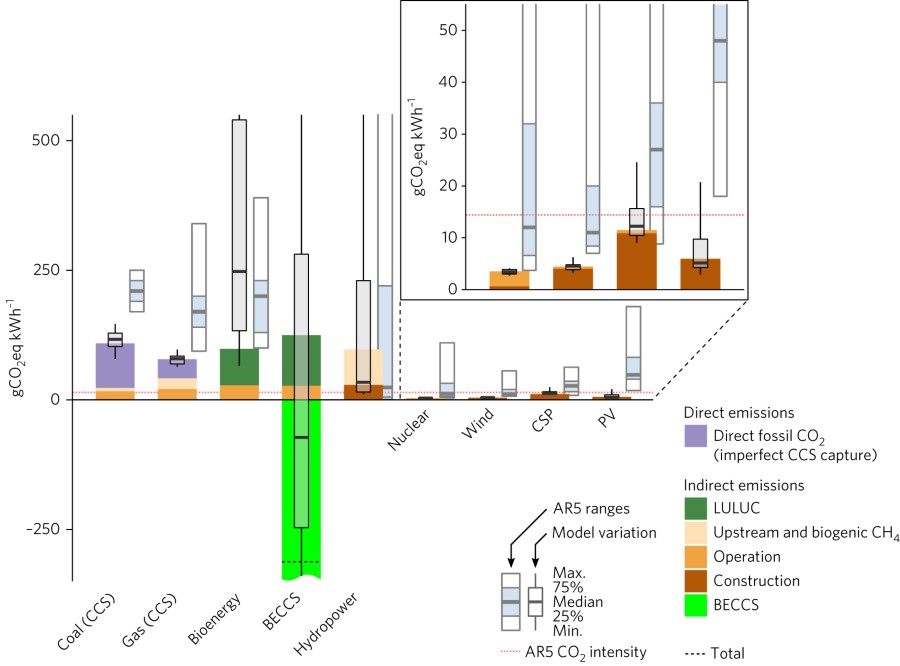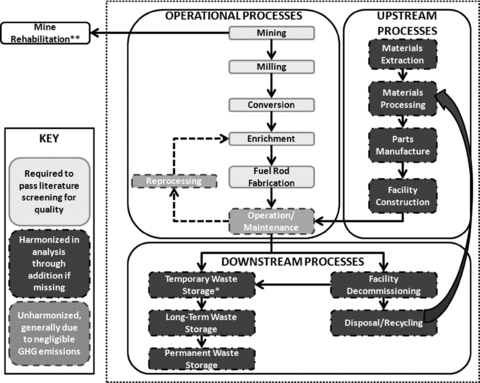The Nuclear Energy Conundrum
The Nuclear Energy Conundrum
I have lost count of the times that a typical IE conversation among classmates ends with the sentence:- "Indeed LCA results are so diverse and dependent on the scope of the analysis..." "that it is almost impossible to know what to advocate". Or in other words, I have no idea if to use the paper cup or the ceramic cup :D
Well this is just an example of what I struggle many times when engaging into sustainability-related discussions with friends. Recently I was discussing sustainability over breakfast with friends and it sucks to give an answer that points to the variability in LCA results. Ending the sentence with "yeah it depends on what you account for and what you defined as boundary" is not really conclusive and it draws an idea upon sustainability that is not really the one that we should have. People want clear and concrete answers on where to start to make a difference everyday. I told him to buy less clothes and reduce his material footprint, explained why and it sounded credible. I earned my Kudos this time :)
But not always Kudos are distributed and sometimes doing our homework may help us in other contexts. This is what happened about 1 month ago when we were having the typical IE lunch talking about sustainability and how the whole world is conspiring against sustainable development. We were talking about clean energy and I mentioned a podcast that I had come across the week before on the topic on nuclear energy made by "Anatomy of next". In this podcast, some interesting facts are mentioned like:
- New reactor designs operating at atmospheric pressure require less material to contain pressure differences
- Re-usage of spent fuel and decrease in fuel needs
- Molten salt or phase-change metal as energy buffer. Also called light-element-moderated reactors
- State-of-the-art designs that are much more advanced than the current light water reactor (LWR)
- Drastic decreases in material needs to build such installations (yes because LWR can operate at 100 bar meaning less efforts in containing pressure difference in the event of an accident)
- Surge in graduating students in nuclear engineering to pre-3 mile island accident in the 70's
- Most accidents that happened worldwide had catastrophic outcomes because of LWR technology
- A company called Transatomic Power says that with molten salt reactors, the benefits are overwhelming.
After listening to this podcast I was like WOW! I need to re-inform myself and build my own unbiased opinion on the topic to be able to counter environmentalist propaganda that might not be supported at all by scientific facts (which is most of the times the case of IE discussion - although I always strive to know the facts before expressing my opinion). Then I started to check online more about nuclear technology and found so much information that I postponed a bit my deep dive into nuclear technology. But I think here's a good start: World Nuclear and Wikipedia. A bit shorthanded but in time of exams, there's no time to learn new things and I decided to stick to my initial question on the CO2 footprint of nuclear...
So I decided to go out there and check if there was an LCA, the famous savior of sustainability discussions. Yes there is and I'll to that later. Now let's stick to something I found in a PhD thesis of one of our Professors in IE Rene Klein. In chapter 4 of his thesis, there is the article "metal requirements for low-carbon power generation".
In this article something that I suspected for a long time was there to prove my intuition: that indeed nuclear power has a lower carbon footprint when compared to other energy generation technologies on an LCA basis.
 |
| Figure 1: CO2 emissions of different power generation technologies. From [1] |
The authors used a model in which the material requirements per kW output are multiplied by the necessary increase in the kWh portfolio according to the future scenarios developed by the International Energy Agency. What is also interesting is the material requirements that each technology has which is reported in figure 2 below. Not the most intuitive chart but is clearly shows the high material intensity of biomass rape seed boiler and solar.
 |
| Figure 2: Requirements of selected metals in different power generation technologies. From [1] |
So it seems that nuclear is as green as a lettuce in terms of CO2 emissions. Quite remarkable given all the bad publicity that it gets. Although spent nuclear fuel is still a problem but promising new designs will be able to use spent nuclear fuel.
On the other hand, the famous IE researcher Edgar Hertwich together with some other reference authors in the field like Sangwon Suh have published in 2015 in the PNAS a very nice article similar to the one of Kleijn but with a more integral approach because it considers a year-by-year approach until 2050 of the life-cycle impacts of these different energy generation technologies and how they will impact in terms of material consumption, GWP, etc.. They have not included nuclear because of incoherences that will be explained later in this post. They conclude that the increased pressure in our environment to manufacture and run all that new renewable energy capacity will be little when compared to the overall benefit in terms of CO2 reduction. This is a nice assumption and it paves the way for the "safe" promotion of renewable energies knowing that the material pressure that they exert will not outweigh its benefits. This is something that I always wondered but know I'm more convinced of their benefit. I really recommend the article, it's a nice read!
Another one, more recently published in December 2017 by Michaja Pehl et al, has included nuclear energy in the calculations of total life-cycle embodied emissions and has not surprisingly found that nuclear is the energy source with the lower life-cycle CO2 equivalent emissions / kWh produced.
 |
| Figure 4: Specific direct and indirect GHG emissions. From [6] |
And now some LCA data! Warner & Heath have done a detailed review of over 274 references on the topic of LCA of nuclear energy (unfortunately only for LWR type of reactor) and they found out that a huge discrepancy exists between results. Values can range between 9 and 220 gCO2/kWh. As I read it, this can be because of many studies not fully complying with ISO 14040 or just because the scope of the study did not take into account in a systematic way all the steps required to perform a correct LCA on nuclear power like in the figure below.
 |
| Figure 4: Life cycle assessment (LCA) harmonization system boundaries (dotted line box) for nuclear power electricity generation. From [3] |
The sustainable development scenario by the IEA states: "The scenario is designed to support the achievement of climate change commitments, the full realisation of which is contingent both on commensurate efforts outside the energy sector and the pace of energy sector decarbonisation after 2040. It reduces energy-related CO 2 emissions to 18.3 Gt in 2040, more than 17 Gt below the level of the New Policies Scenario." [2] This scenario appears to be the only scenario where a more inclusive society exists that gives access to electricity to everyone and that aims at respecting the 2degC warming threshold.
 |
| Figure 5: Connecting individual policy targets in the Sustainable Development Scenario. From [2] |
But as it can be seen in figure 5 below, it will imply a compounded annual growth rate (CAGR) of 3% yearly until 2040. This is still less than for solar and wind but still not negligible.
 |
| Figure 6: Electricity generation profiles in Current Policies scenario and Sustainable Development scenario by the IEA. From [2]. |
I feel that IE people around me have a very negative opinion towards nuclear power. Yet it presents itself as one of the ways to have a more sustainable society by contributing to curb CO2 emissions, decrease air pollution and bring affordable power to new urban populations. The new technologies coming in generation IV combined with the increased number of graduates in nuclear engineering aiming at decreasing climate change, nuclear might even play a more prominent role.
 |
| Figure 7: Nuclear Energy Systems Deployable no later than 2030 and offering significant advances in sustainability, safety and reliability, and economics. From [4] |
Because as concluded in the paper by out Professor Rene Kleijn: "The transition to a sustainable energy system is a prerequisite for a sustainable future but there are hurdles, some of which are not that obvious. In the end, changing the worlds energy system to reduce GHG-emissions is a huge operation with huge implications for the worlds material system as well. There are all kinds of feedback mechanisms and dynamics involved that make it difficult to oversee all implications. (...) Whatever the future energy system will look like, at least we can be sure that the days of “easy”, i.e. material-extensive energy, are over. It is very important to explore all the implications of such a change to support the transition to a new energy system, in order to make it a sustainable system and catch any drawbacks in an early stage." Therefore in IE we should have a more open-mind towards nuclear and specially looking forward have to have new LCAs on the reactors used in generation IV before drawing up short-sighted conclusions.
Of course in remote locations, and due to the burden of building power transmission infrastructure, solar will still be an advantage because of its availability in the regions that are due to rise from poverty (Africa, India, etc). But there's no reason to ignore nuclear for now.
This blog entry was proudly funded by the coffee machine in the Wijnhaven building of the Leiden University in The Hague.
Sources:
- René Kleijn, Ester van der Voet, Gert Jan Kramer, Lauran van Oers, Coen van der Giesen, Metal requirements of low-carbon power generation, Energy,Volume 36, Issue 9, 2011, Pages 5640-5648, ISSN 0360-5442, https://doi.org/10.1016/j.energy.2011.07.003.
- OECD. 2017. World Energy Outlook 2017. Paris: OECD Publishing. https://webstore.iea.org/world-energy-outlook-2017
- Warner, Ethan S., and Garvin A. Heath. "Life cycle greenhouse gas emissions of nuclear electricity generation." Journal of Industrial Ecology 16.s1 (2012).
- https://en.wikipedia.org/wiki/Generation_IV_reactor
- Hertwich, E. G., Gibon, T., Bouman, E. A., Arvesen, A., Suh, S., Heath, G. A., ... & Shi, L. (2015). Integrated life-cycle assessment of electricity-supply scenarios confirms global environmental benefit of low-carbon technologies. Proceedings of the National Academy of Sciences, 112(20), 6277-6282.
- Pehl, M., Arvesen, A., Humpenöder, F., Popp, A., Hertwich, E. G., & Luderer, G. (2017). Understanding future emissions from low-carbon power systems by integration of life-cycle assessment and integrated energy modelling. Nature Energy, 2(12), 939.



Comments
Post a Comment